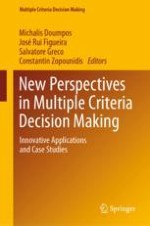2019 | OriginalPaper | Chapter
Multi-criteria Evaluation in Public Economics and Policy
Author : Giuseppe Munda
Published in: New Perspectives in Multiple Criteria Decision Making
Publisher: Springer International Publishing
Activate our intelligent search to find suitable subject content or patents.
Select sections of text to find matching patents with Artificial Intelligence. powered by
Select sections of text to find additional relevant content using AI-assisted search. powered by
